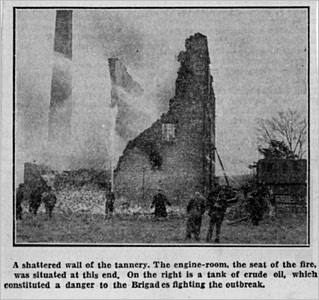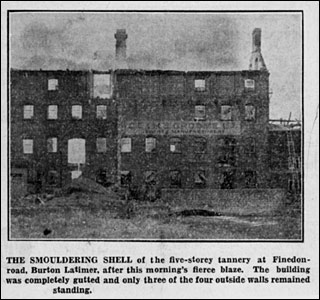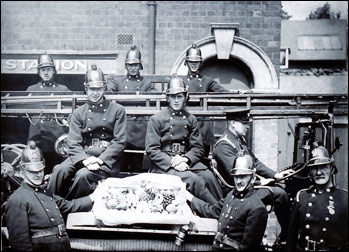| Original Article by Douglas Ashby, transcribed by Sally Crane | |||
|
|||
|
|||
|
In April 1936 two disastrous fires occurred within 24 hours of each other. The first was a serious blaze in The large five-storey building known as the Mill Factory, Twelve men working on a night shift, had to dash to safety, when one of the worst fires in memory at Burton Latimer swept through the factory. Fortunately no one was injured but The outbreak originated in the engine room of the tannery which was on the ground floor and was discovered by Mr Harry Miller who was in charge of the room. He had left the engine to attend to some other duties and on returning saw to his horror that the room was ablaze, and impossible to enter because of the heat. He dashed upstairs to warn the men who were working on four of the five storeys of the building, two being on the fourth floor. A fire extinguisher was hopeless against the blaze. The failure of the lighting system within a few minutes added to the confusion, the lights being dependent on a dynamo driven by an oil engine in the engine room. The shafting to the dynamo was quickly burnt and the lights went out. One workman, a Mr Blackwell who was the last to come out of the burning building, was still on the stairs when the lights failed. The alarm to the Burton Latimer fire brigade was given by The brigade made an exceptionally smart turn-out, the fire engine with
Water could not have been any nearer than it was for the brigade, but unfortunately gravel which was drawn from the mill stream into the pump choked one of the valves, with the result that full pressure of water from the hoses would not be obtained for some time. About The outbreak originated in the engine room of the factory, which is on the ground floor, and was discovered by Mr. Harry Miller, who was in charge of the room. He had left the engine to attend to some other duties, and on returning saw to his horror that the room was ablaze. “I could see a glow on the glass partition and found that it was quite impossible owing to the heat to enter the engine room,” he told the “Evening Telegraph”. “I dashed upstairs to warn my mates who were working on four of the five storeys of the building, two being on the fourth floor. Then we got a fire extinguisher, but it was hopeless to try to put out the blaze.” “One of the helpers, Mr. Samuel Love, apparently lost his cigarette case in the office, and he amazed me by going back to look for it. The smoke and heat caused him almost to collapse and I had to go in and help him down the stairs.” One young woman clerk hurried to the scene, she was When an “Evening Telegraph” reporter visited the fire the interior of the factory presented a scene of indescribable chaos. A few charred beams stretching from wall to wall were the only signs left of the four different floors which the building had contained. Hanging precariously across a beam here and there was some bits of iron lodged where they happened to have fallen. On the floor, littered several feet deep, was the remains of the leather and machinery which the building had contained. A mill has stood on this particular site probably for the hundreds of years. The present building, which now lies in ruins, was erected about 70 years ago. It was occupied for many years by Messrs. Dolben and also by Messrs. Ward, and was taken over by C. E. and H. B. Groome, Ltd., about 14 years ago. A remarkable coincidence connected with the fire is that it is situated at the very spot which Burton Latimer has used on several occasions for practice turnouts. A few months ago Mr. H. B. Groome had a damaging fire in the nursery of his Northampton-road residence. The Groome brothers later decided the ruined tannery including the 100ft chimney stack, should be completely demolished. |
|||


